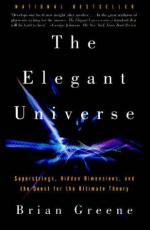
|
| Name: _________________________ | Period: ___________________ |
This test consists of 15 multiple choice questions and 5 short answer questions.
Multiple Choice Questions
1. What is the Planck mass?
(a) The typical mass of a vibrating string.
(b) The average mass gained by a string when it changes to a higher-frequency pattern.
(c) The typical energy of a quark.
(d) The typical mass created by quantum foam over one nano-second.
2. Which of the following is NOT an actual version of string theory?
(a) Type I theory.
(b) Fermionic type IV theory.
(c) Heterotic type O(32) theory.
(d) Type IIA theory.
3. Quantum physics began with the study of the energy inside a heated, closed container, such as an oven. The problem with theories at the time was that they predicted that _____.
(a) The oven can store more energy the smaller it is.
(b) The oven can only store energy if it has no mass.
(c) The oven contains infinite energy.
(d) The oven contains no energy.
4. What are the components of an atomic nucleus?
(a) Photons and electrons.
(b) Electrons and neutrons.
(c) Protons and electrons.
(d) Protons and neutrons.
5. In Einstein's famous equation, E=mc^2, what does "c" represent?
(a) The object's density.
(b) The frequency of light.
(c) The speed of light.
(d) The speed of the object.
6. Which of the following was the first string theory?
(a) Hadron string theory.
(b) Fermionic string theory.
(c) Bosonic string theory.
(d) Lepton theory.
7. According to special relativity, which of the following is true about the passage of time for an observer moving near the speed of light?
(a) The passage of time could not be predicted.
(b) Time would pass slowly compared to an observer at rest.
(c) No time would pass at all.
(d) Time would pass very quickly compared to an observer at rest.
8. Two theories form the basis of modern physics, but are incompatible with one another. String theory attempts to reconcile these fields. What are these two theories?
(a) General relativity and special relativity.
(b) Gravity and general relativity.
(c) Quantum mechanics and the photoelectric effect.
(d) General relativity and quantum mechanics.
9. In 1968 it was discovered that protons and neutrons are composed of which type of particle?
(a) Neutrinos.
(b) Muons.
(c) Baryons.
(d) Quarks.
10. According to Newton's theory of gravity, if two objects have a gravitational pull on one another, and one changes its mass or distance from the other, how quickly does the effect of this change travel to the other object?
(a) Near the speed of light, faster for more massive objects.
(b) Instantaneously.
(c) At exactly the speed of light.
(d) Near the speed of light, faster for lighter objects.
11. According to special relativity, which of the following can move faster than light?
(a) Nothing can move faster than light.
(b) Quantum data.
(c) Gravitational waves.
(d) Neutrinos.
12. Which of the following is true regarding experimental confirmation of string theory?
(a) It has been experimentally confirmed, but the data are still being processed.
(b) It can never be confirmed.
(c) It has not yet been experimentally confirmed.
(d) It was confirmed in the 1980s.
13. According to general relativity, the change that an object causes in the fabric of space-time depends directly on _____.
(a) Its direction compared to the observer.
(b) Its mass.
(c) Its proximity to another massive body.
(d) Its density.
14. What characteristic of the string determines the properties of the particle it represents?
(a) Its mass.
(b) The number of other strings with which it is threaded.
(c) Its length.
(d) Its frequency of vibration.
15. What is the fundamental particle, the smallest possible bundle of energy, for the electromagnetic force?
(a) The gluon.
(b) The photon.
(c) The neutrino.
(d) The electron.
Short Answer Questions
1. What is the quantum, or messenger particle, of gravity?
2. How are the wavelength of a string's vibration and the mass of the particle it represents related?
3. Which of the following is a correct statement, based on the theory of special relativity?
4. In which particle was spin first discovered?
5. What discovery about string theory triggered the "superstring revolution"?
|
This section contains 733 words (approx. 3 pages at 300 words per page) |

|




